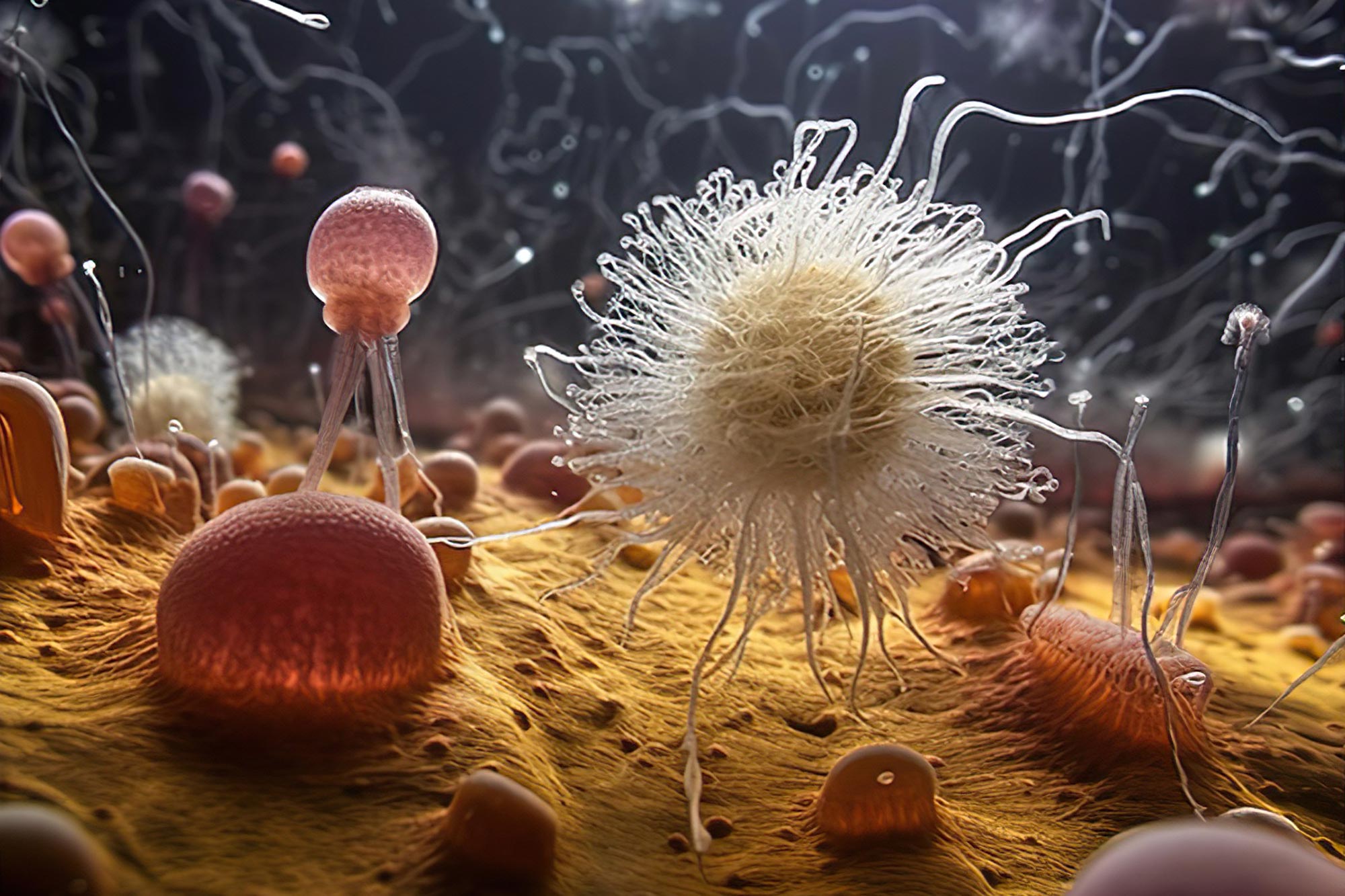door
Artistieke verbeelding van een groep primitieve eukaryoten van de “Protosterol Biota” die leven op een bacteriële mat op de oceaanbodem. Op basis van moleculaire fossielen leefden de Protosterol Biota-organismen ongeveer 1,6 tot 1,0 miljard jaar geleden in de oceanen en zijn onze oudst bekende voorouders. Krediet: georganiseerd op MidJourney door TA 2023
Een multinationaal onderzoeksteam heeft oude protosteroïden in de rotsen gevonden, wat aangeeft dat er al 1,6 miljard jaar geleden complex leven bestond. Deze moleculen bieden nieuw inzicht in de evolutie van het complexe leven en verzoenen discrepanties tussen de traditionele en lipide fossielenbestanden.
Het blijkt dat het nieuw ontdekte record van zogenaamde protosteroïden verrassend overvloedig was gedurende de middeleeuwen van de aarde. Primordiale moleculen werden geproduceerd in een vroeg stadium van de complexiteit van eukaryoten – waardoor het huidige record van fossiele sterolen tot na 800 en zelfs 1.600 miljoen jaar geleden werd uitgebreid. Eukaryoten is een term die wordt gegeven aan het koninkrijk van het leven, inclusief alle dieren, planten en algen en wordt gescheiden van bacteriën door een complexe cellulaire structuur te hebben die een kern omvat, evenals een complexer moleculair mechanisme.
“Het hoogtepunt van deze ontdekking is niet alleen een uitbreiding van het huidige moleculaire record van eukaryoten”, zegt Christian Hollmann, een van de co-wetenschappers van het Duitse onderzoekscentrum voor geowetenschappen (GFZ) in Potsdam. “Gezien het feit dat de laatste gemeenschappelijke voorouder van alle moderne eukaryoten, inclusief wij mensen, waarschijnlijk in staat was om ‘gewone’ moderne sterolen te produceren, is het waarschijnlijk dat de eukaryoten die verantwoordelijk zijn voor deze zeldzame handtekeningen thuishoren in de stam van de fylogenetische boom.”

Benjamin Nettersheim, een van de hoofdauteurs van de studie, onderzoekt elementaire en moleculaire kaarten met superresolutie van 1,64 miljard jaar oude gesteentemonsters die zijn geanalyseerd in het Geobiological Molecular Imaging Laboratory van MARUM. Credit: MARUM – Centrum voor Mariene Ecologie, Universiteit van Bremen; in Descamps
Deze “stronk” vertegenwoordigt de gemeenschappelijke voorouderlijke lijn die de voorloper was van alle levende takken van eukaryoten. Zijn vertegenwoordigers zijn al lang uitgestorven, maar details over hun aard kunnen meer licht werpen op de omstandigheden rond de evolutie van het complexe leven. Hoewel er meer onderzoek nodig is om te beoordelen welk percentage protosteroïden een zeldzame bacteriële bron kan hebben, verzoent de ontdekking van deze nieuwe moleculen niet alleen het geologische record van traditionele fossielen met dat van fossiele vetmoleculen, maar geeft het ook een zeldzaam en ongekend kijkje in de wereld. verloren van het oude leven. De competitieve ondergang van eukaryoten uit de stamgroep, gekenmerkt door de eerste verschijning van moderne fossiele stromalen ongeveer 800 miljoen jaar geleden, kan een van de meest duurzame gebeurtenissen in de evolutie van een steeds complexer leven weerspiegelen.
voegt Benjamin Nittersheim van Marom, Universiteit van Bremen toe, die de studie samen met Jochen Brooks van[{” attribute=””>Australian National University (ANU) – “due to potentially adverse health effects of elevated cholesterol levels in humans, cholesterol doesn’t have the best reputation from a medical perspective. However, these lipid molecules are integral parts of eukaryotic cell membranes where they aid in a variety of physiological functions. By searching for fossilized steroids in ancient rocks, we can trace the evolution of increasingly complex life.”

Dr. Nettersheim inserts a thin section and rock slices of 1.64 billion-years old rocks into the 7T solariX XR FT-ICR-MS equipped with a MALDI source at the Geobiomolecular Imaging Laboratory at MARUM. As part of ongoing research into mid-Proterozoic biomarker signatures at MARUM, GFZ and the Australian National University, Dr. Nettersheim aims to zoom into the cradle of eukaryotic life in unprecedented resolution. Credit: MARUM – Center for Marine Environmental Sciences, University of Bremen; V. Diekamp
Nobel laureate Konrad Bloch had already speculated about such a biomarker in an essay almost 30 years ago. Bloch suggested that short-lived intermediates in the modern biosynthesis of steroids may not always have been intermediates. He believed that lipid biosynthesis evolved in parallel with changing environmental conditions throughout Earth history. In contrast to Bloch, who did not believe that these ancient intermediates could ever be found, Nettersheim started searching for protosteroids in ancient rocks that were deposited at a time when those intermediates could actually have been the final product.
But how to find such molecules in ancient rocks? “We employed a combination of techniques to first convert various modern steroids to their fossilized equivalent; otherwise, we wouldn’t have even known what to look for,” says Jochen Brocks. Scientists had overlooked these molecules for decades because they do not conform to typical molecular search images. “Once we knew our target, we discovered that dozens of other rocks, taken from billion-year-old waterways across the world, were oozing with similar fossil molecules.”
The oldest samples with the biomarker are from the Barney Creek Formation in Australia and are 1.64 billion years old. The rock record of the next 800 million years only yields fossil molecules of primordial eukaryotes before molecular signatures of modern eukaryotes first appear in the Tonian period. According to Nettersheim “the Tonian Transformation emerges as one of the most profound ecological turning points in our planet´s history“. Hallmann adds that “both primordial stem groups and modern eukaryotic representatives such as red algae may have lived side by side for many hundreds of millions of years”. During this time, however, the Earth’s atmosphere became increasingly enriched with oxygen – a metabolic product of cyanobacteria and of the first eukaryotic algae – that would have been toxic to many other organisms. Later, global “Snowball Earth” glaciations occurred and the protosterol communities largely died out. The last common ancestor of all living eukaryotes may have lived 1.2 to 1.8 billion years ago. Its descendants were likely better able to survive heat and cold as well as UV radiation and displaced their primordial relatives.
“Earth was a microbial world for much of its history and left few traces,” Nettersheim concludes. Research at ANU, MARUM and GFZ continues to pursue tracing the roots of our existence – the discovery of protosterols now brings us one step closer to understanding how our earliest ancestors lived and evolved. Shooting at the ancient rocks with a laser coupled to an ultra-high resolution mass spectrometer in MARUM’s globally unique Geobiomolecular Imaging Laboratory, Dr. Nettersheim and his international collaborators aim at zooming into the cradle of eukaryotic life in unprecedented resolution to further improve our understanding of our early ancestors in the future.
Reference: “Lost world of complex life and the late rise of the eukaryotic crown” by Jochen J. Brocks, Benjamin J. Nettersheim, Pierre Adam, Philippe Schaeffer, Amber J. M. Jarrett, Nur Güneli, Tharika Liyanage, Lennart M. van Maldegem, Christian Hallmann and Janet M. Hope, 7 June 2023, Nature.
DOI: 10.1038/s41586-023-06170-w
Participating Institutions:
- Research School of Earth Sciences, The Australian National University, Canberra, Australia
- MARUM – Center for Marine Environmental Sciences, University of Bremen, Bremen, Germany
- Faculty of Geosciences, University of Bremen, Bremen, Germany
- Université de Strasbourg, CNRS, Institut de Chimie de Strasbourg, Strasbourg, France
- Northern Territory Geological Survey, Darwin, Australia
- German Research Center for Geosciences (GFZ), Potsdam, Germany
MARUM produces fundamental scientific knowledge about the role of the ocean and the ocean floor in the total Earth system. The dynamics of the ocean and the ocean floor significantly impact the entire Earth system through the interaction of geological, physical, biological and chemical processes. These influence both the climate and the global carbon cycle, and create unique biological systems. MARUM is committed to fundamental and unbiased research in the interests of society and the marine environment, and in accordance with the Sustainable Development Goals of the United Nations. It publishes its quality-assured scientific data and makes it publicly available. MARUM informs the public about new discoveries in the marine environment and provides practical knowledge through its dialogue with society. MARUM cooperates with commercial and industrial partners in accordance with its goal of protecting the marine environment.

“Bierliefhebber. Toegewijde popcultuurgeleerde. Koffieninja. Boze zombiefan. Organisator.”






More Stories
Maak kennis met de NASA-astronauten die als eerste een ruimtevaartuig van Boeing zullen lanceren
NASA begrijpt nog steeds niet de oorzaak van het hitteschildprobleem van Orion
Eerste vlucht van Boeing Starliner-astronaut: live updates